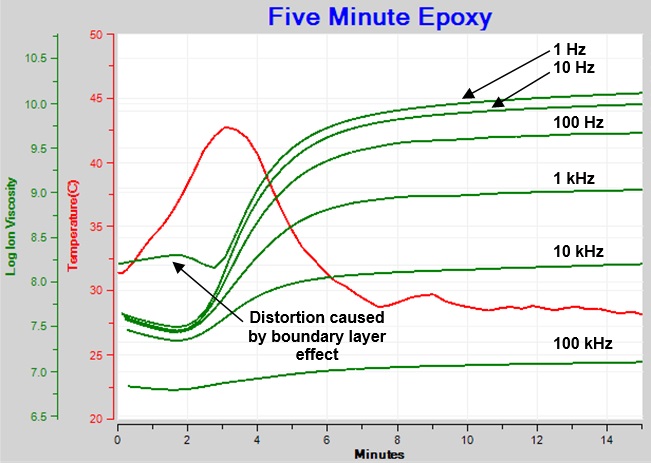Dielectric cure monitor는 다양한 주파수에 걸쳐 AC 신호를 사용하여 열경화성 재료의 전기적 특성을 측정합니다. DC 신호를 사용하여 resistance을 측정하면 재료에 대한 정보를 확인할 수 있지만 사용자가 반드시 고려해야 하는 단점과 제한이 있습니다.
AC 신호를 사용하여 재료의 경화 거동을 분석하면 매 경화 상태에 대한 전반적인 정보를 획득할 수 있습니다. DC 신호를 사용한 방법은 제한적이지만 여전히 유용한 데이터를 제공합니다. resistance monitor는 DC 전압원을 사용하며 평행한 전극 사이의 물질에 전류를 흘려 구동하는 매우 민감한 저항 측정 기기입니다. resistivity는 센서의 구조에 따라 달라지는 scaling factor 만으로 resistance와 다르므로 resistivity에 대한 문제는 resistance에도 동일하게 적용됩니다.
DC 신호를 사용한 측정은 아래 나열된 단점으로 인하여 유연성과 정확성이 떨어지지만 단순성을 유지할 수 있습니다.
1) DC 측정은 DC 저항만 측정이 가능합니다. AC 측정은 capacitance, 주파수에 독립적인 resistance와 주파수에 종속적인 resistance의 측정이 가능합니다. 주파수에 독립적인 resistance는 DC resistance를 설명하는 더 정확한 용어이며 DC를 포함하는 다양한 주파수 범위에서 측정할 수 있습니다.
2) DC 측정은 실제 DC 신호와 구별할 수 없는 회로 내의 offset voltage drift, thermal drift 그리고 leakage current와 같은 체계적인 오류가 가질 수 있습니다.
3) DC 측정은 release layer나 vacuum bag의 측정이 불가능합니다.
4) DC 측정은 전극 분극과 경계층 효과에 의해 왜곡된 데이터를 생성할 수 있습니다.

resistance의 DC 측정은 간단하지만 AC 신호에 의한 경화 거동 분석과 비교해 단점을 갖습니다. 열경화성 재료 또는 복합적인 경화 거동 상태 분석에 있어 전극 분극은 데이터를 왜곡하거나 잘못된 해석을 야기할 수 있습니다. 전극 분극이 저주파 AC 측정에도 영향을 미칠 수 있지만, 유전체 특성을 통해 왜곡된 AC 데이터를 보정할 수 있습니다. 반대로 DC 측정은 보정할 수 없습니다.
Dielectric cure monitors measure the electrical properties of a thermoset with AC signals across a range of frequencies. Measurement of resistance with DC methods can also reveal information about a material, but has disadvantages and limitations that the user must consider.
AC measurements of thermosets can obtain the full range of information about composite cure state. Simpler DC methods provide data that are limited but still useful. Resistance monitors are essentially highly sensitive ohmmeters that use a DC voltage source to drive current through the material between a pair of electrodes. Resistivity differs from resistance by only a scaling factor that depends on sensor geometry, so issues about resistivity apply equally to resistance.
Instruments using DC measurements achieve simplicity while sacrificing flexibility, and possibly accuracy, because of the following disadvantages:
- DC measurements can only obtain DC resistance. AC methods measure capacitance, frequency independent resistance and frequency dependent resistance. Frequency independent resistance is the more accurate term that describes DC resistance and can be measured across a range of frequencies that includes DC.
- DC measurements may have systematic errors such as offset voltage drifts, thermal drifts and leakage currents in circuits that cannot be distinguished from the true DC signal.
- DC measurements are not possible through release layers or vacuum bags
- DC measurements may produce distorted data caused by electrode polarization and the boundary layer effect.
While DC measurements of resistance are simple to make, they have disadvantages compared to AC composite cure monitoring. For thermoset or composite cure monitoring, electrode polarization may distort DC data and cause misinterpretation of cure state. Although electrode polarization can also affect low frequency AC measurements, the additional information gained from dielectric properties allows correction of the distorted AC data. In contrast, correction of DC measurements is not possible.
Reference :
Lambient TechnologiesTM Technical Overview 3.04—AC and DC Composite Cure Monitoring, Page 4
상세한 사항은 아래 첨부된 자료를 참고 부탁 드립니다.
